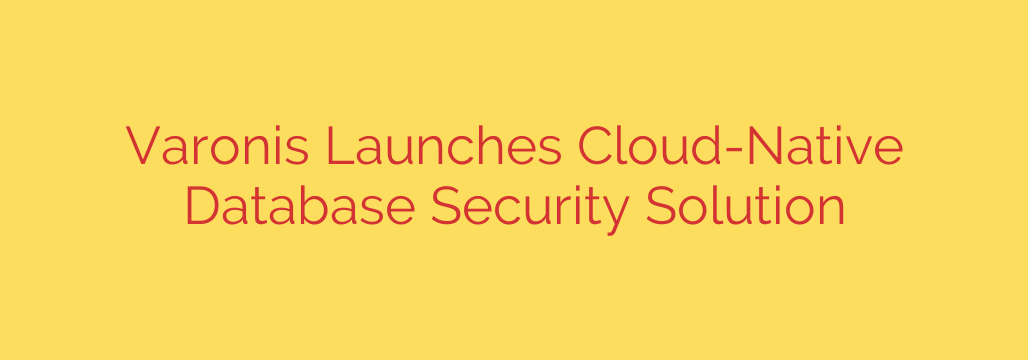
Unlocking Cloud Database Security: How to Protect Your Most Critical Assets
As organizations accelerate their migration to the cloud, a critical security gap is widening. While the benefits of cloud-native databases like Amazon RDS, Aurora, and Google Cloud SQL are undeniable, they also introduce complex new challenges for data protection. Traditional security measures, designed for on-premise environments, often fall short, leaving your most sensitive information exposed.
The reality is that securing data in a dynamic cloud environment is fundamentally different. The lack of a clear perimeter, the complexity of Identity and Access Management (IAM) policies, and the rapid pace of development can create a perfect storm for data breaches. To navigate this new landscape, a modern approach focused on visibility, threat detection, and granular control is no longer optional—it’s essential.
The Core Challenge: You Can’t Protect What You Can’t See
The first step in securing any asset is knowing it exists. In the cloud, sensitive data can be scattered across numerous databases, including platforms like PostgreSQL, SQL Server, MySQL, and MariaDB. Manually tracking this information is an impossible task, which is why a foundational element of modern cloud security is automation.
A robust security strategy must begin with automated discovery and classification of sensitive data. This process continuously scans your cloud databases to identify and tag critical information, such as:
- Personally Identifiable Information (PII)
- Payment Card Industry (PCI) data
- Protected Health Information (PHI)
- Intellectual property and trade secrets
By understanding exactly where your “crown jewel” data resides, you can begin to build effective, targeted security policies around it.
Moving from Reactive to Proactive: Advanced Threat Detection
Once you have visibility into your data, the next priority is detecting malicious activity before it turns into a catastrophic breach. Legacy security tools often rely on known signatures, leaving them blind to novel attacks and insider threats.
Modern cloud database security shifts the focus to behavior. By leveraging machine learning and User and Entity Behavior Analytics (UEBA), new solutions can establish a baseline of normal activity for every user and account. This allows for the proactive detection of suspicious patterns that indicate a potential threat, such as:
- Unusual Data Access: An employee suddenly accessing a sensitive database they’ve never touched before.
- Potential Data Exfiltration: A service account beginning to download unusually large volumes of data.
- Privilege Escalation: A user attempting to gain higher levels of access than they require for their role.
- Compromised Credentials: Login activity from an unusual geographic location or at an odd time of day.
This behavioral approach enables security teams to spot subtle indicators of compromise and respond swiftly to neutralize threats.
Taming the Chaos: Mastering Access and Permissions
One of the biggest security risks in the cloud is the prevalence of excessive permissions. Over-privileged accounts—both human and non-human—are a primary target for attackers. If a compromised account has sweeping access to your data, the potential for damage is immense.
Achieving a state of “least privilege,” where accounts have only the minimum access required to perform their function, is critical. This requires comprehensive visibility into data access and permissions. An effective security platform provides clear, actionable insights into who can access what data, highlighting risky configurations like:
- Publicly exposed databases.
- Overly permissive IAM roles.
- Accounts with stale or unused privileges.
By identifying and remediating these vulnerabilities, you dramatically reduce your attack surface and strengthen your overall security posture. This level of visibility is also crucial for simplifying audits and demonstrating compliance with regulations like GDPR, CCPA, and HIPAA.
Actionable Steps to Enhance Your Cloud Database Security
Protecting your cloud data requires a focused, proactive effort. Here are essential security tips you can implement today:
- Conduct a Comprehensive Data Audit: Deploy tools that can automatically scan your cloud environment to discover and classify all sensitive data. You cannot secure what you do not know you have.
- Enforce the Principle of Least Privilege: Regularly review user and service account permissions. Revoke excessive or unused access rights to minimize the potential impact of a compromised account.
- Monitor for Abnormal Behavior: Implement a security solution that uses behavioral analytics to detect suspicious activity. Pay close attention to alerts regarding unusual data access, large downloads, or changes in privileges.
- Integrate Security into DevOps (DevSecOps): Ensure that security is part of your development lifecycle from the beginning. Scan for vulnerabilities and misconfigurations in infrastructure-as-code templates before they are deployed.
Ultimately, securing cloud-native databases is a continuous process, not a one-time project. By embracing modern tools that provide deep visibility, intelligent threat detection, and granular control, you can confidently leverage the power of the cloud while ensuring your most valuable assets remain protected.
Source: https://datacenternews.asia/story/varonis-unveils-cloud-native-solution-for-database-security








